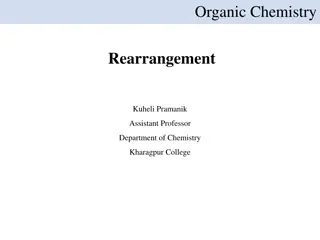Understanding the Pinacol-Pinacolone Rearrangement in Organic Chemistry
The Pinacol-Pinacolone rearrangement is a crucial process in organic chemistry for converting 1,2-diols into carbonyl compounds. This rearrangement involves a 1,2-migration under acyl conditions, resulting in the shift of two adjacent atoms. Learn about the mechanisms, products, and uses of Pinacolone, a significant ketone derived from this reaction.
Download Presentation

Please find below an Image/Link to download the presentation.
The content on the website is provided AS IS for your information and personal use only. It may not be sold, licensed, or shared on other websites without obtaining consent from the author. Download presentation by click this link. If you encounter any issues during the download, it is possible that the publisher has removed the file from their server.
E N D
Presentation Transcript
Pinacol Pinacolone rearrangement is a very important process in organic chemistry for the conversion of 1,2 diols into carbonyl compounds containing a carbon oxygen double bond. This is done via a 1,2-migration which takes place under acyl conditions.
Pinacol Pinacolone Rearrangement Process The pinacol pinacolone rearrangement process takes place via a 1,2-rearrangement as discussed earlier. This rearrangement involves the shift of two adjacent atoms. This reaction is a result of the work of the German chemist William Rudolph Fittig who first described it in the year 1860. Pinacol and Pinacolone Pinacol is a compound which has two hydroxyl groups, each attached to a vicinal carbon atom. It is a solid organic compound which is white in colour.
The IUPAC name of Pinacolone is 3,3-dimethyl-2-butanone. Pinacolone is a very important ketone. It has a peppermint like or camphor like odour and appears to be a colorless liquid. Pinacol Pinacolone Reaction The pinacol pinacolone rearrangement proceeds through the formation of an intermediate which is positively charged. The methyl group in this intermediate proceeds to migrate from one carbon to another. This reaction can be given by:
Pinacol Pinacolone Rearrangement Mechanism The Pinacol Pinacolone rearrangement mechanism proceeds via four steps. Each of these steps are explained below. Step 1: Since the reaction is carried out in an acidic medium, the hydroxide group of the pinacol is protonated by the acid. Step 2: Water is now removed from the compound, leaving behind a carbocation. This carbocation is tertiary and therefore stable. Step 3: The methyl group shifts to the positively charged carbon in a rearrangement of the compound. Step 4: The oxygen atom which is doubly bonded to the carbon is now deprotonated, giving rise to the required pinacolone. This reaction mechanism can be illustrated as:
Thus, the required Pinacolone product is generated. It is important to note that this rearrangement is regioselective in nature. The rearrangement of the more stable carbocation yields the major product.
Uses of Pinacolone The uses of the pinacolone product produced from the pinacol pinacolone rearrangement include: Pinacolone is used in Pesticides, Fungicides, and Herbicides. Pinacolone is used to prepare the cyanoguanidine drug pinacidil. Another drug use of Pinacolone is its use in Stiripentol, which is used to treat epilepsy. Pinacolone is used to produce triadimefon which is used to control fungal diseases in agriculture. The primary applications of pinacolone are in the drug industry.
An acid-induced rearrangement of oximes to give amides. This reaction is related to the Hofmann and Schmidt Reactions and the Curtius Rearrangement, in that an electropositive nitrogen is formed that initiates an alkyl migration.
Mechanism of the Beckmann Rearrangement Generally have a high barrier to inversion, and accordingly this reaction is envisioned to proceed by protonation of the oxime hydroxyl, followed by migration of the alkyl substituent "trans" to nitrogen. The N-O bond is simultaneously cleaved with the expulsion of water, so that formation of a free nitrene is avoided.























![The Synthesis of Cedranoid Sesquiterpenes via Photo-Rearrangement of Bicyclo[2.2.2] Octenones](/thumb/198279/the-synthesis-of-cedranoid-sesquiterpenes-via-photo-rearrangement-of-bicyclo-2-2-2-octenones.jpg)